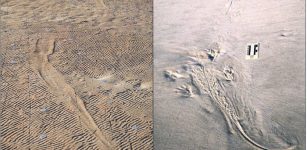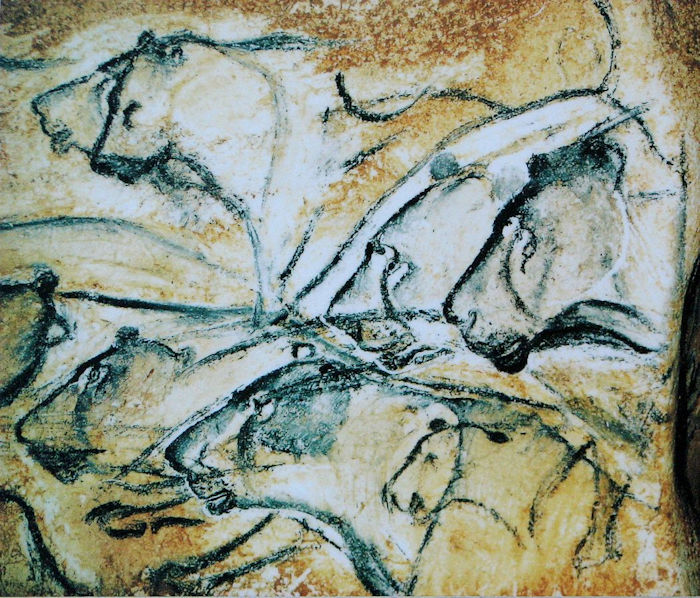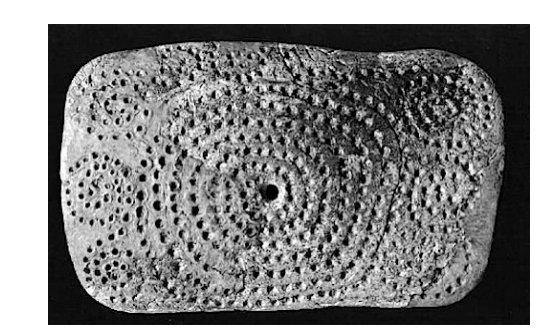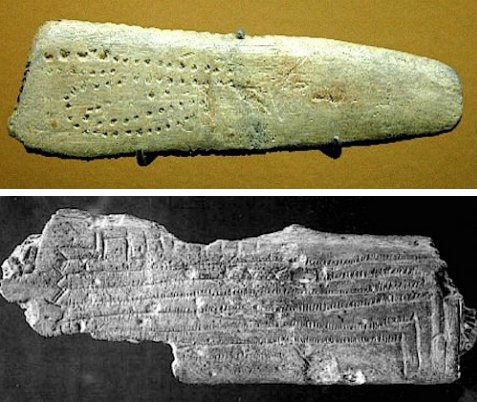Astonishing Lunar And Solar Calendars Created 30,000 B.C.
Ellen Lloyd - AncientPages.com - At first glance, these ancient artifacts may look like ordinary bones covered with insignificant dots. That is not the case, however.
Closer examination of carved-engraved bone plates discovered in France has revealed people created astonishing lunar and solar calendars 30,000 B.C.
Chauvet-Pont d'Arc cave replica, the lions "fresco". Credit: HTO - Public Domain
For as long as anyone can remember, people have been fascinated with the night skies. There are many examples of how our ancestors’ profound interest in astronomy.
Observations of celestial objects took place in many prehistoric societies. Today, we can admit that ancient astronomers possessed advanced knowledge about the Sun, the Moon, asteroids, various solar planets, and interesting cosmic events. When and where people started to study the heavens and celestial objects is impossible to say, but if we turn our attention to Europe, we discover something quite extraordinary.
European Paleolithic works of art can be dated to approximately 30 000 BC. and are considered one of the achievements of the Upper Paleolithic cognitive revolution. The earliest cave paintings in La Grotte Chauvet-Pont-d’Arc, France were created about 31 000 years ago. Not only are the images a great example of prehistoric art, but they have also motivated researchers to attempt to “decipher” the meaning and purpose behind some of the ancient symbols.
While examining Paleolithic cave art scientists discovered that Paleolithic people had a great interest in astronomy.
Alexander Marshack (1918-2004), an American independent scholar and Paleolithic archaeologist, was one of the first scientists who stated astronomy played an essential role during the Upper-Paleolithic era.
He studied ancient bone fragments discovered in French caves. He interpreted the various Paleolithic and Mesolithic, mostly portable, objects that bear engraved or painted series of dots or lines as accurate lunar observations.
Juan Antonio Belmonte writes in the book Ancient Astronomy: India, Egypt, China, Maya, Inca, Aztec, Greece, Rome, Genesis, Hebrews, Christians, the Neolithic and Paleolithic that Marshack’s “arguments were based not only on counting the signs but on what he called “microscopic analysis.”
The interpretation of the markings on various artifacts as notational systems rests on the hypothesis of a slow accumulation of these marks, which correlates with lunar or solar motion. Thus he concluded that these artifacts reflect nonarithmetic observational astronomical skills and lore. The most well-known depiction interpreted by him is found on the bone plate about 30 000 years old, from Abri Blanchard (Dordogne, France), which is said to represent the waxing and waning moon positions in serpentine form.”
Top: Abri Blanchard, Dordogne, France. Archaeological Museum. Bottom: Cave of Taï, Drôme, France
“Francesco d’Errico and colleagues developed a different type of methodology (d’Errico 1989). Drawing on experimental archaeology, they compiled a database in an attempt to demonstrate whether the notches represent notational systems or not.
After investigating a great number of artifacts they concluded that there were some objects which might have depicted parts of a series of complex codes based on the hierarchical organization of information, and using formally differentiated marks. One of these artifacts might be the find from the cave Taï (Drôme, France) whose age is about 10 000 years.
After studying Eurasian portable art the Russian investigator B.A. Frolov also became convinced that these objects were calendars following the monthly motion of the moon and/or yearly solar path, and claimed they were used by early communities. The most well-known bone plate interpreted as a lunisolar calendar is from Ma’lta (Irkutskaya Oblast, Russia).”
The theory that people created such complex lunar and solar calendars so long ago may sound somewhat far-fetched. Still, there is a lot of evidence that suggests our ancestors were rather familiar with the movements of the Sun, Moon, and even other planets.
Updated on March 22, 2022
Written by Ellen Lloyd – AncientPages.com
Copyright © AncientPages.com All rights reserved. This material may not be published, broadcast, rewritten or redistributed in whole or part without the express written permission of AncientPages.com
More From Ancient Pages
-
 Ancient Giant Amphibians Swam Like Crocodiles 250 Million Years Ago – New Study
Archaeology | Mar 31, 2023
Ancient Giant Amphibians Swam Like Crocodiles 250 Million Years Ago – New Study
Archaeology | Mar 31, 2023 -
 Accidental Discovery Of Large Trove Of 14th Century Gold And Silver Coins In West Bohemia
Archaeology | Aug 13, 2020
Accidental Discovery Of Large Trove Of 14th Century Gold And Silver Coins In West Bohemia
Archaeology | Aug 13, 2020 -
 ‘Bone Biographies’ Reveal Lives Of Medieval England’s Common People And Illuminate Early Benefits System
Archaeology | Dec 6, 2023
‘Bone Biographies’ Reveal Lives Of Medieval England’s Common People And Illuminate Early Benefits System
Archaeology | Dec 6, 2023 -
 Legendary And Mysterious Stone Of Brutus – The London Stone Refuses To Give Up Its Secrets
Artifacts | Jan 21, 2022
Legendary And Mysterious Stone Of Brutus – The London Stone Refuses To Give Up Its Secrets
Artifacts | Jan 21, 2022 -
 First Kisses May Have Helped Spread Oral Herpes 5,000 Years Ago – Scientists Say
Archaeology | Jul 30, 2022
First Kisses May Have Helped Spread Oral Herpes 5,000 Years Ago – Scientists Say
Archaeology | Jul 30, 2022 -
 Ancient Board Game Mancala Can Unlock Cutting-Edge Physics Discoveries
Artifacts | Sep 30, 2023
Ancient Board Game Mancala Can Unlock Cutting-Edge Physics Discoveries
Artifacts | Sep 30, 2023 -
 Can Stonehenge Be Saved From Bulldozers Or Have Druids Been Defeated?
News | Nov 10, 2020
Can Stonehenge Be Saved From Bulldozers Or Have Druids Been Defeated?
News | Nov 10, 2020 -
 What Was Inti Raymi And Why Was It Celebrated By Inca?
Ancient History Facts | Dec 16, 2017
What Was Inti Raymi And Why Was It Celebrated By Inca?
Ancient History Facts | Dec 16, 2017 -
 Mystery Of The Controversial Phantom Time Hypothesis
Featured Stories | Mar 21, 2019
Mystery Of The Controversial Phantom Time Hypothesis
Featured Stories | Mar 21, 2019 -
 Nammu: Sumerian Goddess Who Got The Idea To Create Mankind In The Image Of Gods
Featured Stories | Apr 1, 2019
Nammu: Sumerian Goddess Who Got The Idea To Create Mankind In The Image Of Gods
Featured Stories | Apr 1, 2019 -
 Unique Maya Center Of Copán With History Recorded In 2500 Hieroglyphics
Civilizations | Nov 7, 2018
Unique Maya Center Of Copán With History Recorded In 2500 Hieroglyphics
Civilizations | Nov 7, 2018 -
 Ancient Human Traces Found In The Inhospitable Namib Desert
Human Beginnings | Oct 21, 2024
Ancient Human Traces Found In The Inhospitable Namib Desert
Human Beginnings | Oct 21, 2024 -
 Ancient Village Of Monsanto, Miraculously Balanced Giant Boulders And Knights Templar Connection
Civilizations | Dec 20, 2018
Ancient Village Of Monsanto, Miraculously Balanced Giant Boulders And Knights Templar Connection
Civilizations | Dec 20, 2018 -
 Sverd I Fjell – Swords In Rock: Battle Of Hafrsfjord Won By Harald Fairhair – First King Of Norway
Featured Stories | Mar 9, 2016
Sverd I Fjell – Swords In Rock: Battle Of Hafrsfjord Won By Harald Fairhair – First King Of Norway
Featured Stories | Mar 9, 2016 -
 Why Did Pirates And Sailors Wear Earrings?
Ancient History Facts | Feb 15, 2016
Why Did Pirates And Sailors Wear Earrings?
Ancient History Facts | Feb 15, 2016 -
 Location of Roman Ballista Machines During The Siege Of Jerusalem – Uncovered
Archaeology | Aug 17, 2022
Location of Roman Ballista Machines During The Siege Of Jerusalem – Uncovered
Archaeology | Aug 17, 2022 -
 Pictograms: First Written Accounts Of Earthquakes In Pre-Hispanic Mexico
Archaeology | Aug 27, 2021
Pictograms: First Written Accounts Of Earthquakes In Pre-Hispanic Mexico
Archaeology | Aug 27, 2021 -
 Puzzling Extinct Giants Depicted On 12,000-Year-Old Rock Paintings In The Colombian Amazon Rainforest Baffle Scientists
Archaeology | Mar 12, 2022
Puzzling Extinct Giants Depicted On 12,000-Year-Old Rock Paintings In The Colombian Amazon Rainforest Baffle Scientists
Archaeology | Mar 12, 2022 -
 Secrets Of The Lost Ancient Sahara Civilization
Civilizations | Oct 26, 2018
Secrets Of The Lost Ancient Sahara Civilization
Civilizations | Oct 26, 2018 -
 Native Americans’ Visions Of Distant Explorers May Unravel Some Ancient Mysteries Of North America – The Arrival – Part 1
Featured Stories | Nov 19, 2019
Native Americans’ Visions Of Distant Explorers May Unravel Some Ancient Mysteries Of North America – The Arrival – Part 1
Featured Stories | Nov 19, 2019



